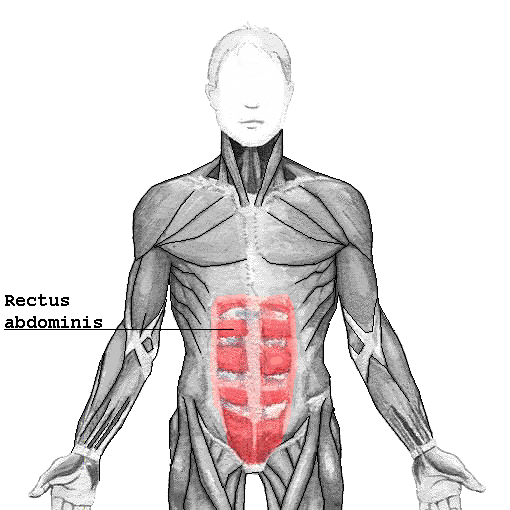
DR may appear as a bulge which becomes more prominent during straining. Sometimes, women who do not realize that they have DR will wonder why it still looks like they are pregnant after they have given birth, assuming that the bulge is pregnancy weight when in fact it is DR. Physical therapists can test for DR by having the client lying in hooklying position (on their back with hips flexed to 45 degrees, knees flexed to ninety degrees, and feel flat on the table). The therapist will have the woman lift her head slightly off the table and palpate how many, if any, fingers of separation are present between the left and right RA at the level of the umbilicus, above the umbilicus, and below the umbilicus. The reason for measuring for DR in all three locations is because DR can exist at, above, or below the belly button. When DR occurs, it usually exists at and/or above the umbilicus.
Fortunately, physical therapy can help reduce DR. Specific exercises that target RA strengthening can help close the gap, literally. The same position and activity that was used to assess DR, hooklying with chin lifts, is the same exercise prescribed for treatment (3-5 second hold, 50x per day). In addition, performing the exercise with a sheet wrapped tightly around the waist (or her hands pressing the two halves of the muscle together) approximates the two halves of the RA and provides closure. Consider the following analogy to better understand how the sheet along with the exercise helps to correct DR. Imagine trying to attach two pieces of paper to one another in perfect alignment, back to front. One would likely use glue to maintain the perfect alignment. So too with correcting DR- wrapping the sheet around the waist properly aligns the left and right RA muscles to one another. But a person doesn’t want to walk around all day holding the two halves of the muscle together, nor do they want to rely on external support to maintain closure. Therefore, performing RA strengthening exercises is akin to glue, which when it “dries” (ie is performed enough times and gets strong enough) can close the gap and maintain the muscles in proper alignment permanently. The sheet realigns and closes the gap and then the exercise is the glue that seals it in its proper place.
Similarly, many patients respond well to taping of the abdominal wall during the initial stages of strengthening. It serves a similar function to the sheet, and it provides additional external closure as the internal support (ie the RA muscles) are building strength. Taping is not intended to be a long term crutch, rather it is a short term treatment enhancer which promotes closure before the muscles are strong enough to perform all the work on their own. Furthermore, abdominal taping increases an individual’s proprioceptive awareness of the very existence of their abdominal muscles. In other words, it serves as a gentle reminder that these muscles exist, which encourages and makes it easier for her to engage the muscles on a routine basis. By doing so, women become more comfortable performing abdominal bracing (strengthening) throughout the day during ordinary activities, such as lifting her baby, carrying groceries, and squatting.
Additional exercises have been shown to help reduce DR, and those are best taught under the direct supervision of a trained physical therapist. Improper technique during exercise performance as well as non-DR friendly core exercises (such as the classic sit-up or crunch) can actually exacerbate DR. Therefore, instruction from a specialist is the best way to ensure that you are heading on the right path. After all, if you are going to be doing all the work, you may as well reap the benefits of doing them properly! If you or someone you know stand to benefit from physical therapy to reduce DR, please contact us at Revitalize Physical Therapy. We would love to help you!


